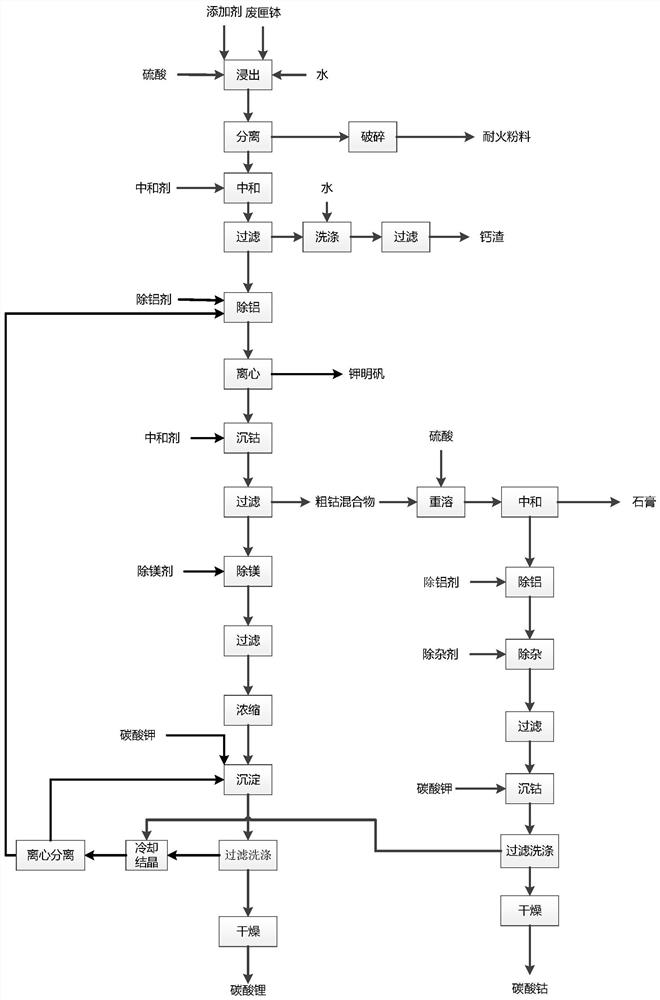A method for recycling waste saggers in the preparation process of lithium cobalt oxide battery materials
A battery material and preparation process technology, applied in the directions of silicate, cobalt carbonate, aluminum sulfate, etc., can solve the problems of comprehensive utilization of no waste saggers, difficult direct recycling, difficult recycling, etc., and achieves good industrial application prospects, The effect of reducing raw material consumption and high recycling rate
- Summary
- Abstract
- Description
- Claims
- Application Information
AI Technical Summary
Problems solved by technology
Method used
Image
Examples
Embodiment 1
[0116] This embodiment provides a method for recycling and processing waste saggers during the preparation of lithium cobalt oxide battery materials. The specific method is:
[0117] (1) immersing the discarded saggar described in Table 1 into the leaching tank of 10L sulfuric acid with a molar concentration of 2 mol / L and reacting, adding 100 mL of hydrogen peroxide as an additive to carry out the leaching reaction at room temperature, taking out the saggar after leaching 10h, the purified The saggar was put into clean water for immersion, and after soaking for 4 hours, the saggar was rinsed with clean water, and the saggar was used for crushing and screening to prepare mullite-cordierite composite ceramic raw materials (refractory powder).
[0118] (2) After repeatedly leaching 10 waste saggers, the leaching solution is first separated by filtration, the filter residue is returned to the leaching tank for deep leaching, and after the washing is completed, it is discharged as...
Embodiment 2
[0132] This embodiment provides a method for recycling and processing waste saggers during the preparation of lithium cobalt oxide battery materials. The specific method is:
[0133] (1) immersing the waste sagger used in Example 1 into the leaching tank of 20L sulfuric acid with a molar concentration of 3 mol / L reacts, adds 800 mL of hydrogen peroxide and carries out leaching reaction at room temperature, takes out the saggar after leaching 8h, and after purification The saggar was soaked in clean water for 4 hours. After soaking for 4 hours, the saggar was rinsed with clean water, and the saggar was used for crushing and screening to prepare mullite-cordierite composite ceramic raw materials.
[0134](2) After repeatedly leaching 22 waste saggers, the leaching solution is first separated by filtration, the filter residue is returned to the leaching tank for deep leaching, and after washing is completed, it is discharged as solid waste, and the filtered filtrate is added with...
Embodiment 3
[0144] This embodiment provides a method for recycling and processing waste saggers during the preparation of lithium cobalt oxide battery materials. The specific method is:
[0145] (1) immersing the waste saggar used in Example 1 in the leaching tank of 10L sulfuric acid with a molar concentration of 2.5mol / L and reacting, adding 600mL of hydrogen peroxide to carry out leaching reaction at room temperature, taking out the saggar after leaching 6h, purifying The latter saggar was soaked in clean water for 4 hours, and the saggar was rinsed with clean water after soaking for 4 hours, and the saggar was used for crushing and screening to prepare mullite-cordierite composite ceramic raw materials.
[0146] (2) After repeatedly leaching 10 waste saggers, the leaching solution is first separated by filtration, the filter residue is returned to the leaching tank for deep leaching, and after washing is completed, it is discharged as solid waste, and the filtered filtrate is added wi...
PUM
 Login to View More
Login to View More Abstract
Description
Claims
Application Information
 Login to View More
Login to View More - R&D
- Intellectual Property
- Life Sciences
- Materials
- Tech Scout
- Unparalleled Data Quality
- Higher Quality Content
- 60% Fewer Hallucinations
Browse by: Latest US Patents, China's latest patents, Technical Efficacy Thesaurus, Application Domain, Technology Topic, Popular Technical Reports.
© 2025 PatSnap. All rights reserved.Legal|Privacy policy|Modern Slavery Act Transparency Statement|Sitemap|About US| Contact US: help@patsnap.com



